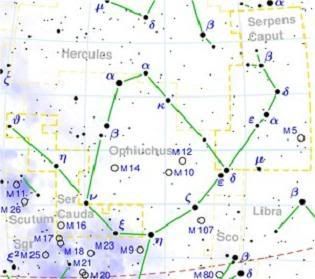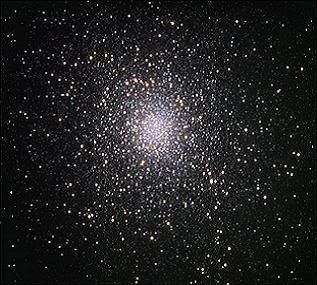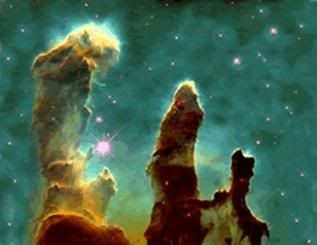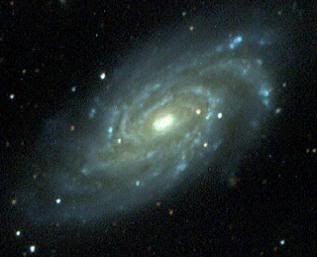Post by glactus on Feb 17, 2008 5:28:23 GMT

In the sky, Serpens the Serpent, is being grasped in the hands of Ophiuchus, the serpent holder. Thus the constellation wraps around Ophiuchus, and is devided into two parts: Serpens Caput (the head) and Serpens Cauda (the tail). The constellation is spread across a greater part of the sky than Ophiuchus, and there are several Messier objects to view as well as some very nice star systems.
Notable stars:
Alpha Serpentis
Alpha Serpentis is a triple star system, A, B and C, and is in the head of the constellation Serpens Caput. Alpha is an orange K-type giant with an apparent magnitude of 2.63, and has a total luminosity of 70 times solar. Alpha Serpentis B, magnitude 11.8, is 58 arcseconds from the primary, and the 13th magnitude Alpha Serpentis C lies 2.3 arcminutes from A. Distance from Earth is 73.2 light years.
HD 168746 is an 8th magnitude star that is very similar to our Sun, a yellow dwarf star (spectral class G5 V). It is not visible to the unaided eye, but is easily visible with binoculars or a small telescope. In 2000 a planet was announced orbiting it. Magnitude is 7.95 and distance from Earth is 140.6 light years.
HD 175541
HD 175541 is an intermediate-mass subgiant star of Spectral Type, G8IV. That means when this star was a main-sequence, it was an A-type star.
Apparent visible Magnitude is 8.03, and distance from Earth is 416 light years.
R Serpentis
R Serpentis is a long-period variable with a period of 356.41 days. The star is located 1.2 degrees ESE of beta Serpentis, nearly midway between beta and gamma Serpentis and very slightly south of a line drawn between them. It is receding from us at about 23 km/s. Magnitude is 5.16, and estimated distance from Earth is 600 light years.
Notable objects:

Hoag's object
Hoag's Object is a non-typical galaxy of the type known as a ring galaxy. The appearance of this object has interested amateur astronomers as much as its uncommon structure has fascinated professionals. Many of the details of the galaxy remain a mystery, foremost of which is how it formed. So-called "classic" ring galaxies are generally formed by the collision of a small galaxy with a larger disk-shaped galaxy. However, there is no sign of any second galaxy that would have acted as the "bullet", making the typical formation hypothesis quite unlikely. Magnitude is 16.2, and it is some distance from Earth is 600 million light years.

Messier M 5
Spanning 165 light-years across, M5 is one of the largest globular clusters known. The gravitational sphere of influence of M5 has a radius of some 200 light-years. At 13 billion years old it is also one of the older globulars associated with the Milky Way Galaxy. The distance of M5 is about 24,500 light-years away from Earth and the cluster contains more than 100,000 stars up to perhaps 500,000 according to some estimates. Magnitude is at 6.5.

Pillars of Creation in Messier M 16
Messier M 16, the Eagle Nebula (NGC 6611) is perhaps one of the most famous and easily recognized space objects. It is associated with a diffuse emission nebula, or H II region, which is catalogued as IC 4703 and contains the famous Pillars of Creation, one of the most photogenic objects in the universe. This region of active current star formation is about 7,000 light-years distant and easily visible with good binoculars. Magnitude is 7.42.

NGC 6070
The large bright galaxy, NGC 6070 is receding from the Earth with a velocity of about 2000 kilometers per second and is at a distance of over 100 million light years. The blue light in the galaxy comes from recently formed hot stars; the yellowish light comes from cooler, older stars. NGC 6070 is helping astronomers celebrate "First Light" (the first test sky images) for an exciting new telescope built to perform the ambitious Sloan Digital Sky Survey. Magnitude is 11.7.

credits:
Serpens map: Wikipedia
en.wikipedia.org/wiki/Serpens
image: Hoag's object: NASA/ESA and The Hubble Heritage Team STScI/AURA)
www.spacetelescope.org/images/html/opo0221a.html
image: Eagle nebula: pillars of creation
www.secondarylife.com/tax.htm
image: secondarylife
www.secondarylife.com/tax.htm
image: NGC 6070: apod/nasa
http://www. apod.nasa.gov/apod/ap980610.html


